| Sign up to get the latest endangered species news. |
|
| |
|
| |
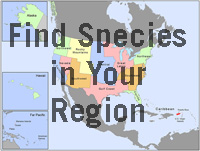 |
| |
|
| |
|
| |
|
| |
|
Critics of the Endangered Species Act contend it is a failure because only 1 percent of the species under its protection have recovered and been delisted. The critique, however, is undermined by its failure to explain how many species should have recovered by now. It is a ship without an anchor.
To objectively test whether the Endangered Species Act is recovering species at a sufficient rate, we compared the actual recovery rate of 110 species with the projected recovery rate in their federal recovery plans. The species range over all 50 states, include all major taxonomic groups, and have a diversity of listing lengths.
We found that the Endangered Species Act has a remarkably successful recovery rate: 90 percent of species are recovering at the rate specified by their federal recovery plan.
You can read a copy of our 2012 report On Time, On Target: How the Endangered Species Act Is Saving America’s Wildlife here. Click here to see a regional map of species recovering around the country.
On average, species recovered in 25 years, while their recovery plan predicted 23 years — a 91 percent timeliness accomplishment.
We confirmed the conclusion of scientists and auditors who assert that the great majority of species have not been listed long enough to warrant an expectation of recovery: 80 percent of species have not yet reached their expected recovery year. On average, these species have been listed for just 32 years, while their recovery plans required 46 years of listing.
The study’s findings are similar to a 2006 analysis of all federally protected species in the Northeast, which found 93 percent were stabilized or improving since being put on the endangered species list and 82 percent were on pace to meet recovery goals.
When judged in the light of meeting recovery plan timelines for recovery, the Endangered Species Act is remarkably successful. Few laws of any kind can boast a 90 percent success rate.
SPECIES HIGHLIGHTS
|
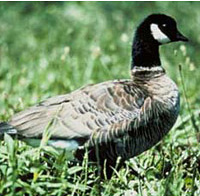
|
 |
Aleutian Canada goose. Once nearly driven extinct by foxes introduced to their nesting islands in Alaska and by habitat destruction and hunting in California and Oregon, Aleutian Canada geese are today a clear success story. After a small population was found on a remote Alaskan island in the Aleutian chain, the goose was listed as an endangered species in 1967. Nonnative fox populations were controlled, nesting habitat was protected with the Alaska Maritime National Wildlife Refuge’s creation in 1980, and wintering and migration habitat was protected in California and Oregon. The Aleutian Canada goose population grew from 790 birds in 1975 to more than 60,000 in 2005. It was downlisted to “threatened” in 1990, declared recovered and removed from the endangered list in 2001, seven years earlier than projected by its recovery plan. |
|

|
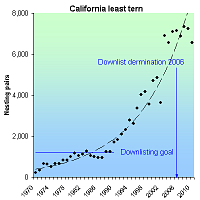 |
California least tern. The decline of these small seabirds that like to fish for anchovies and smelt in the shallow coastal waters of central and Southern California began in the late 19th century, due to the desirability of their feathers for women's hats. In the decades after the Migratory Bird Treaty Act of 1916 ended that threat, populations again began to plummet as habitat was wiped out by development and recreational pressures. By the 1940s, terns were extirpated from most beaches of Orange and Los Angeles counties and were considered sparse elsewhere. When listed as endangered in 1970, just 225 nesting tern pairs were recorded in California. Protection of nest beaches from development and disturbance, and active predator-control programs, allowed the species to steadily increase to about 7,100 pairs in California in 2004. In 2006 the U.S. Fish and Wildlife Service recommended downlisting of the California least tern. In 2010 a population of 6,568 was recorded. |
|

|
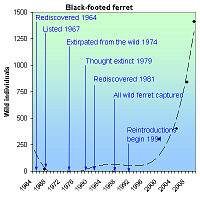 |
Black-footed ferret. This 2-foot-long, black-masked member of the weasel family once occurred in central grasslands and basins from southern Canada to Texas but is now one of the most endangered mammals in North America. In the early 1900s, the United States was likely home to more than 5 million ferrets. But ferrets, which hunt prairie dogs for food and live in their burrows, were almost wiped out early in the 20th century after agricultural development and rodent poisons devastated prairie dog populations. Thirteen years after they were listed as endangered in 1967, the last captive ferret died, and the animals were thought to be extinct in North America. Then in 1981 a small relic population was discovered in a Wyoming prairie dog colony. Between 1991 and 1999, about 1,200 ferrets from that population were released in Wyoming, Montana, South Dakota, Arizona and along the Utah/Colorado border. At least two of those reintroduced populations are established and no longer require releases of captive-raised ferrets. Biologists estimate there are now a total of about 1,410 black-footed ferrets living in the wild. |
|
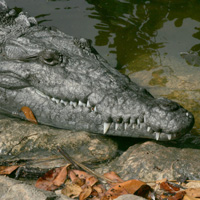
|
 |
American crocodile. In pre-Columbian days, the coastal tip of South Florida was literally crawling with thousands of American crocodiles. By the time they were listed as endangered in 1975, hunting for sport and skins as well as overcollection for zoos and museums had reduced their numbers to as few as 200. With the entire population, including only 10 to 20 breeding females, living in one small area of northeastern Florida Bay, American crocodiles were in stark danger of becoming little more than a memory. But only eight years after gaining Endangered Species Act protection, populations had grown to about 1,000, and crocodiles had already returned to much of their historic range, from Biscayne Bay and Key Largo to Florida’s southwestern coast. In 2005 the crocodiles’ numbers reached 2,085, and two years later the species was downlisted to threatened. |
|
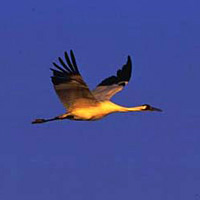
|
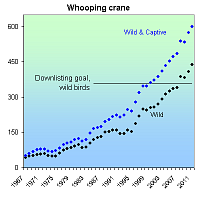 |
Whooping crane. Iconic whooping cranes in flight, their long necks thrust forward and legs trailing behind, almost disappeared from North American skies after unregulated hunting and habitat destruction reduced their numbers from as many as 1,400 in the late 1800s to as few as 21 by 1938. By the time it was listed as endangered in 1967, the population of America’s tallest bird had dropped to just 48 wild and six captive birds. In 1978, critical habitat was designated in parts of Idaho, Kansas, Nebraska, Oklahoma and Texas, primarily on federal and state wildlife-management lands. The bird whose habitat once stretched from the Arctic coast south to central Mexico, and from Utah east to New Jersey, South Carolina, Georgia and Florida, now nests in the wild at only three locations: Wisconsin, Central Florida, and Wood Buffalo National Park and adjacent areas in Canada (a population that winters in Aransas National Wildlife Refuge, Texas). Due to intensive habitat management, nest protection, captive breeding and reintroductions, the population rose steadily to 513 birds in 2006, and 599 in 2011. |
|
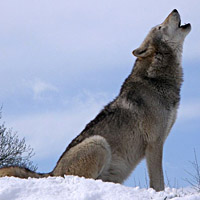
|
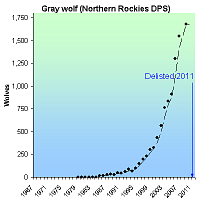 |
Gray wolf, northern Rocky Mountains. Between the late 19th century and 1967, when wolves were listed as endangered, bounty hunting wiped out most of the wolf population in the lower 48 states, leaving populations in only northeastern Minnesota and Isle Royal, Mich. Successful recolonization of the Rocky Mountain region began in the early 1980s, and wolves were reintroduced to Yellowstone National Park and Idaho in the mid-1990s. In 2009 the total population of wolves in the northern Rockies was about 1,679, up from 1,545 in 2007 and 1,300 in 2006. The population then began expanding beyond the Rockies; wolves started returning to Oregon in 1999, and the first pack, the Imnaha, was established in 2008. There are now four confirmed packs in eastern Oregon and at least 29 wolves. The first reliable reports of wolves returning to Washington came in 2005; today the state has five packs in the central and eastern portions of the state, including three breeding pairs and at least 27 individuals. The U.S. Fish and Wildlife Service delisted the northern Rockies gray wolf in 2008, but the decision was overturned after conservationists successfully argued that the recovery plan goal was outdated and insufficient to remove the threat of extinction. In 2011, for the first time in the history of the Endangered Species Act, Congress overruled the courts and ordered the delisting of northern Rockies gray wolves, along with those in parts of Oregon, Washington and Utah. Wolf populations in Idaho and Montana are now subject to aggressive hunting and trapping seasons designed to severely reduce populations. |
|

|
 |
Shortnose sturgeon. Once found in rivers and estuaries along the Atlantic seaboard, the shortnose sturgeon was nearly driven extinct by overfishing, bycatch, river damming, habitat destruction and poor water quality. It was placed on the endangered list in 1967, and now at least five populations have increased. One of the most impressive sites has been New York’s Hudson River, where fishing prohibitions and habitat protection efforts increased the population from 12,669 in 1979 to more than 60,000 today. Some biologists have suggested removing the Hudson River population from the endangered list as a recovered species. |















